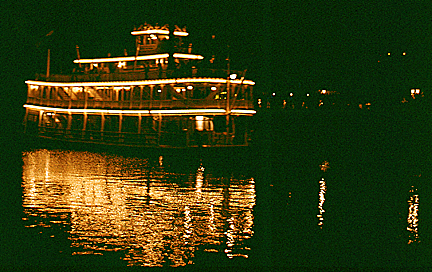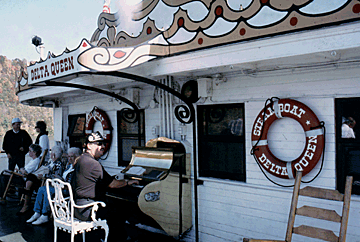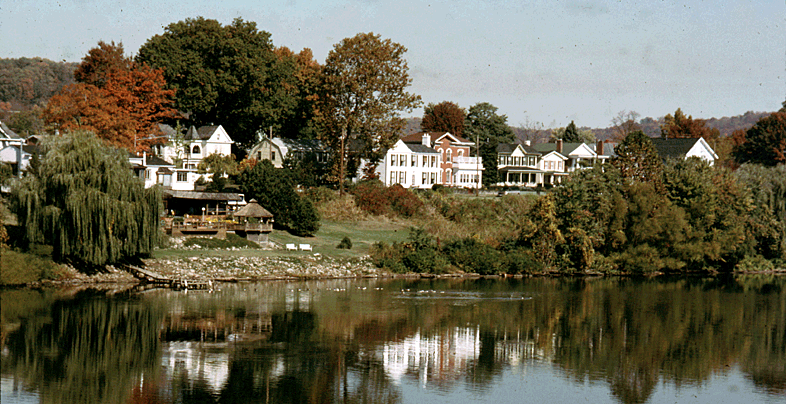 As evening approaches, the river takes on a shimmering
glow, as the moon rises amidst wispy clouds. We sail along to the tune of
Scott Joplin's Maple Leaf Rag. The stars twinkle as the ragtime tunes waft
out on the breeze, filling the night air with their joyful melodies. As evening approaches, the river takes on a shimmering
glow, as the moon rises amidst wispy clouds. We sail along to the tune of
Scott Joplin's Maple Leaf Rag. The stars twinkle as the ragtime tunes waft
out on the breeze, filling the night air with their joyful melodies.
The next day I awake early to the hum of the engines as the boat docks at
Maysville, Kentucky. The river has a softness to it as the mist floats just
above the surface.
Breakfast offers rich thick luscious pecan rolls—one item on a
buffet of many—fresh fruit, muffins, cereals, hot cakes, grits, and baked
ham. In addition, each table gets a large eight-inch round stack of sticky
buns smothered in pecans and lots of hot coffee.
As the morning lingers on, the river takes on a bright yellow glow. I set
out to explore Old Washington, a frontier town not far from Maysville.
After a lunch of a shrimp po'boy sandwich, cornbread and crab salad, we
depart Maysville to "Waitin' for the Robert E. Lee." The calliope
echoes back to us from the surrounding hills.
The wind picks up as "Dixie" bellows out of the pipes.
 The calliope, or steam "pieana," is to steamboats what jelly is
to peanut butter. Invented by Joshua Stoddart, this unique instrument of 32
copper whistles connected to steam pipes was originally designed to be
mounted on a church steeple to call worshippers to service. Unfortunately,
that didn't work, but it did just fine on steamboats, accompanying
departures all along the river. The calliope, or steam "pieana," is to steamboats what jelly is
to peanut butter. Invented by Joshua Stoddart, this unique instrument of 32
copper whistles connected to steam pipes was originally designed to be
mounted on a church steeple to call worshippers to service. Unfortunately,
that didn't work, but it did just fine on steamboats, accompanying
departures all along the river.
It's 2:30 P.M. The upper deck is deserted. It's just me and the river. Rene Robert Cavelier Sieur de La
Salle discovered the Ohio River. He
named it La Belle Riviere. The Indians called it the Ohio. The day heats up.
From the remains of an old dock along the shore boys dive and splash in the
river.
Caretakers watch over a graveyard of rusty rails and wheels. Quiet now
are the rail cars that once carried coal and ore to furnaces near
Pittsburgh. Gone is the flare of furnaces, the shriek of warning whistles,
the army of sweating, smoke-grimed workers pounding out the nation's steel.
Mile after mile, the river flows by these tombstones to a bygone era.
A tow, pushing four barges, comes thumping up river and rumbles by. Lots
of birds live along the river—ospreys (fish hawks), great blue herons,
ducks in small flotillas along the shore.

As I drink my morning coffee on our second full day out, the Delta Queen
drifts through a soft muggy morning mist rising like steam from the
pond-like river. A sparkling morning on the Ohio is a wash-job for the soul.
I spot a large hawk in a sycamore tree. A mother duck leads her small convoy
of ducklings across the Queen's bow.
To see America, the river is still the best road. All along the way,
little river towns cling without apparent effort to the charm of a bygone
era. Towns along the river tend to ebb and flow rather like the river,
itself. Some spring booming to life, then falter, decline and die.
There's a certain air of tried hope and American resilience about towns
that have seen better days and are trying hard to come back. Towns where
the once-fine hotel is now a senior citizens' residence, and the bank
building is being considered for a museum. The best looking buildings are
old, of another era. Portsmouth, Ohio, is like that.
Next: Part 3 |
